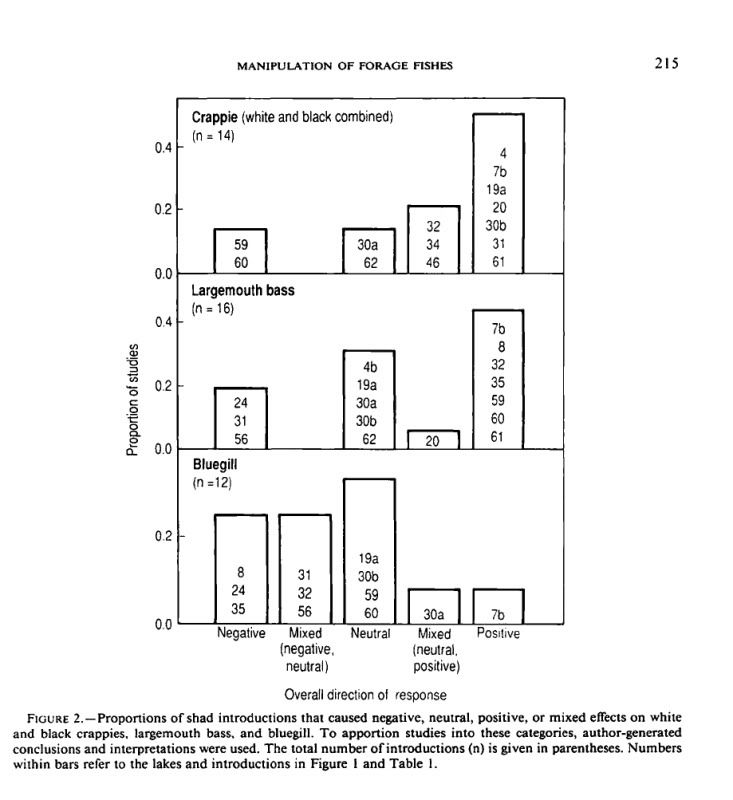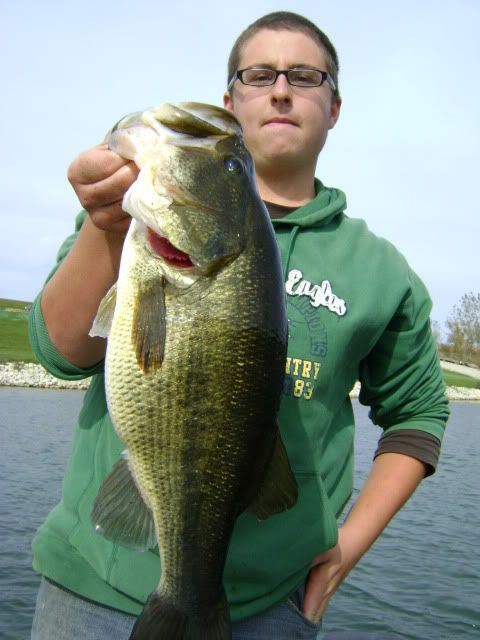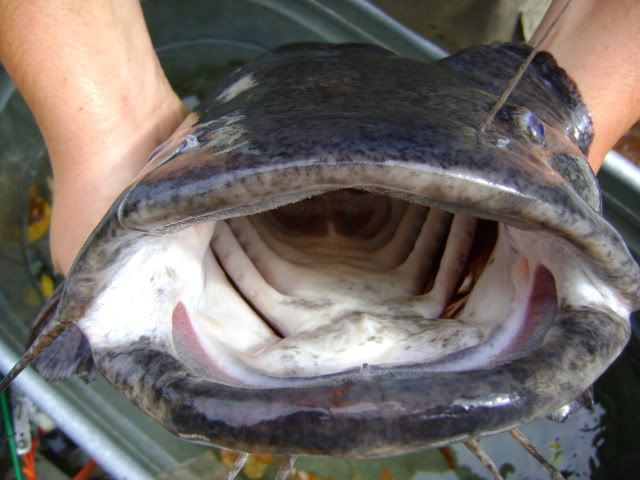I went back and looked at the studies and several more on the subject. The methods and data are sound and involved at least 20 professional top notch FS writing in peer reviewed method. The Nutt article (not a study) is based on those and is clear about its purpose “trophy LMB”. You can state your opinion. You can not make statements like "I personally feel that the studies that try to claim that TS or gizzard shad either one do not affect bluegill size, are at the very best poorly substantiated and researched with shoddy methods and conclusions, and at worst just skewed science." , questioning the ability and ethics of a number of professionally trained Fisheries Scientists. I don’t think Bob wants defamatory statements placed on the forum.
Here is the info so others can read it and make their own choice.
Walt have you read the studies not the abstracts ? I have seen shad added to many lakes/ponds with all different outcomes. I have read many studies on the subject both as to GShad and Tshad. Generalizations are suspect. I have added below some text which should show the uncertainty and differences. From these I gather that GShad are a problem unless you want and have big LMB as noted above. TShad are not the same as they often don't compete significantly with BG and don't suppress the recruitment of LMB and BG like GShad. Even in the GShad studies it is not so much the competition for food as it is reduced predation on BG and other factors. The last study below is an examination of some 60 prior studies on GShad and TShad as forage .
Direct and indirect effects of gizzard shad on bluegill growth and population size structure
"These results demonstrate that the presence of gizzard shad is associated with reduced bluegill growth rates and adult size structure and that mechanisms other than direct competition for food resources may be responsible"
Effects of Waterbody Type and Management Actions on Bluegill Growth Rates
"Managers should recognize basic differences in growth patterns between water body types when determining which management actions should be implemented or when evaluating their success."
The Influence of Gizzard Shad (Dorosoma clpedianum) on Plankton Community Dynamics in Earthen Ponds
Date: 1995
Abstract: The impacts of gizzard shad on plankton community interrelationships were evaluated in six, 2 to 5 ha ponds over a 3-year period. All ponds were stocked with largemouth bass (Micropterus salmoides) and sunfish (Lepomis spp.). Three of the six ponds were stocked with gizzard shad at random while the other three served as controls. The zooplankton and phytoplankton were sampled and analyzed three times during 1992 (before shad introduction) and twice a month during the growing seasons of 1993 and 1994. Water quality variables were measured once in 1992 and every other month during the growing seasons of 1993 and 1994. Phytoplankton primary productivity was measured three times in 1992 before the introduction of shad and once a month during the growing seasons of 1993 and 1994. Zooplankton density, biomass and size were affected by gizzard shad during summer, 1993 and spring and fall of 1994. Statistical differences between treatments occurred in spring, 1994 (p<0.13) with higher density, higher biomass, and smaller organisms in the shad treatment. Phytoplankton density, diversity and primary productivity were all higher in the shad treatments (p<0.13) during fall, 1994. Shad influenced the plankton community in a web-like fashion directly impacting zooplankton and phytoplankton simultaneously and indirectly affecting phytoplankton by altering the zooplankton. Shad shifted phytoplankton size structure by first reducing large phytoplankton (>70 mm) in the shad treatment immediately after shad introduction in 1993 and enhancing small phytoplankton (C28 mm) a year after shad introduction (1994). Through this size structuring, shad increased the photosynthetic efficiency of the phytoplankton community to twice that of ponds without shad by summer, 1994 (p =0.067) and increased primary productivity to 1.5 times that of ponds without shad by fall, 1994 (p =0.098).
Relationships between trophic state and gizzard shad, bluegill sunfish, and largemouth bass populations in three Alabama impoundments
Date: 1989
Abstract: Three Alabama impoundments were studied to analyze the relationship between fertility levels and the population and community structures of several species of fish. Chlorophyll a concentrations were used to classify lake trophic status. Fish communities and populations were similar in structure between the two eutrophic systems and differed from the oligotrophic system. Eutrophic systems were shown to have a higher relative abundance of prey species, in particular gizzard shad. Overall production was lower in the oligotrophic systems. Community structure in the eutrophic systems reflected a greater influence of gizzard shad. Bluegill abundance doubled while gizzard shad numbers increased twentyfive-fold. Largemouth bass increased eight times in number. Prey populations were overcrowded, characterized by slow growth, poor condition, and reduced spawning, due to the high relative abundance of gizzard shad. Predator populations showed low recruitment and poor condition in smaller fish due to lack of suitable size prey.The relative abundance of predator species increased in the oligotrophic system. Bluegill were in better condition and had better distribution across size classes. Young of year and age one gizzard shad were absent from sampling throughout the year.
Title: The effects of threadfin shad as a forage species for largemouth bass in combination with bluegill, redear, and other forage species
Date: 1976
Abstract: Threadfin shad, Dorosoma petenense (Gunther), were stocked in ponds with an established population of bass, bluegill, and redear and in three ponds containing bass, golden shiners, and fathead minnows. Comparisons of fish populations were made before and after the first successful spawn of shad. The production of bass with bluegill and redear plus shad was essentially the same as with golden shiners and fathead minnows--59.2 pounds per acre and 58.7 pounds per acre, respectively. A significant increase in the growth and condition of bass was seen in the pond stocked with bluegill and redear after the first shad spawn while no change was seen in bass survival.Bluegill and redear recruitment increased significantly after the shad population became established. This apparently was caused by a decreased rate of predation by bass. As a result, the catch per unit of effort of bluegill and redear decreased significantly after the introduction of shad. Bass were in better condition after shad stocking while no change in the condition of bluegill and redear could be detected. In ponds stocked with forage minnows, fathead minnows disappeared the second summer after stocking. An F/C ratio (Forage/Carnivorous) of 2.7 and an A value for bass (percentage of bass over 10 inches in length) of 93.4 was computed for the pond, indicating a bass-crowded condition due to heavy predation on the forage species.From these data, the stocking of shad as additional forage in bass-bluegill-redear ponds cannot be recommended. The stocking of shad with bass and other forage species appears to offer some advantages to bass fishermen if the production of forage species can be increased.
Stocking Threadfin Shad: Consequences for Young-of-Year Fishes
DENNIS R. DEVRIES, ROY A. STEIN, and JEFFREY G. MINER
Ohio Cooperative Fish and Wildlife Research Unit,3 and Department of Zoology The Ohio State University, Columbus, Ohio 43210, USA
GARY G. MITTELBACH
Kellogg Biological Station, Michigan State University, Hickory Corners, Michigan 49060, USA
Abstract
Threadfin shad Dorosoma petenense are commonly introduced into reservoirs to supplement prey available to piscivorous fishes. To determine how early life stages of threadfin shad and their potential competitors and predators interact, we introduced this species into two Ohio lakes—Clark and Stonelick—and evaluated how its young of year influenced young-of-year bluegills Lepomis macrochirus and largemouth bass Micropterus salmoides. After adults were stocked in April, peak abundance of young-of-year threadfin shad occurred in August in both lakes. Bluegills generally spawned earlier than threadfin shad, which apparently reduced competition between young of these species. In Clark Lake, young-of-year threadfin shad did not reduce zooplankton populations, but in Stonelick Lake, peak abundance of young-of-year threadfin shad was followed by a precipitous decline in zooplankton. Data on cladoceran birth rates indicated this decline was due to increased predation by threadfin shad. Survival of bluegills to a size at which they move into the littoral zone also declined in Stonelick Lake, perhaps because of the virtual elimination of zooplankton. Limited survival of bluegills in turn contributed to reduced growth of young-of-year largemouth bass dependent on them as prey. Given that zooplankton declined in one but not the other lake, interactions among young-of-year fishes due to annually introduced threadfin shad will likely vary among systems and years. Nonetheless, introduced threadfin shad could, in some systems in some years, negatively affect growth and recruitment of the very species they were meant to enhance.
Young-of-year threadfin shad, though their abundance peaked in late summer, co-occurred at low densities with limnetic young-of-year bluegills during May through September in Clark Lake. When both species co-occurred in the limnetic zone, they ate only limnetic zooplankton; however, diet overlap values were typically <0.50. Once blue gills moved inshore, the potential for
competition with threadfin shad declined greatly.Diets of bluegills collected from the littoral zone did not change between 1987 and 1988 in Clark Lake; all prey types (littoral, limnetic, and cyclopoid copepods) were eaten. Though collected inshore, bluegills apparently moved far enough offshore to consume some limnetic prey, but they ate enough littoral prey to reduce overlap with threadfin shad, which continued to feed entirely on limnetic prey. Consequently, although competition between young-of-year bluegills and young-of-year threadfin shad may occur (particularly during August in Stonelick Lake), the outcome of such interactions in a lake ultimately depends on abundance and species composition of the zooplankton community and on the relative spawning times of the predator fishes. As demonstrated by our results, these factors vary among lakes and years, making generalization difficult.Thus, interactions between limnetic young-ofyear threadfin shad and bluegills may have a pronounced negative effect on young-of-year largemouth bass growth if they lead to reduced survival young-of-year bluegills in the limnetic zone and then to reduced recruitment of bluegills to the littoral zone. Additionally, slower growth may reduce overwinter survival of young-of-year largemouth bass if overwinter survival depends on body size and fat reserves (Adams et al. 1982a, 1982b; reviewed in Adams and DeAngelis 1987). As a consequence, the very management practice intended to enhance the fishery for adult piscivores may reduce survival of the target species. Although these negative effects are not direct (unlike the positive effects of increased prey availability), they could have substantial consequences over several years of such management manipulation
Manipulating Shad to Enhance Sport Fisheries
in North America: An Assessment
DENNIS R. DEVRIES' AND ROY A. STEIN
Manipulating forage fish populations to enhance sport fisheries is a common management practice. Here we review the literature dealing with manipulations of gizzard shad Dorosoma cepedianum and threadfin shad D. petenense to assess whether or not this practice has been successful. Shad introduction has tended to enhance predators, such as white crappie Pomoxis annularis, black crappie P. nigromaculatus, and largemouth bass Micropterus salmoides, and negatively affect presumed competitors, such as bluegill Lepomis macrochirus. However, responses have not been consistent within a species: some studies document negative responses of predators or positive responses of competitors to shad introduction. Depending on the study, target species have experienced negative, neutral, and positive effects due to shad removal, making generalizations impossible. We were not able to generalize about how shad influence sport fishes. Although bluegill appeared to be more negatively affected by shad than crappies, the response of largemouth bass being intermediate between the two, we cannot draw definite conclusions because the entire range of results occurred for each target species.
The chart tells the story - in half of the 12 studies addressing the effect on BG by shad 6 were positive to neutral and 6 were negative to neutral. But more important are the statements that blanket generalizations were not possible. 
The results presented here indicate that several aspects of whole systems must be quantified if we are to assess how forage-fish manipulations affect a fish community. Based on our review of manipulations involving gizzard and threadfin shad, potential competition and predation, spatial refuges, indirect effects through common predators and prey, and the influence of ontogenetic shifts in habitat and diet of the target and introduced species are all critical to being able to predict the influence of a forage-fish manipulation on a target species.
_________________________
Here is the original discussion thread on the K Nutt article in PB.
http://www.pondboss.com/forums/ubbthreads.php?ubb=showflat&Number=11350&fpart=1Here is a later discussion.
http://www.pondboss.com/forums/ubbthreads.php?ubb=showflat&Number=159008&fpart=1Walt you made my point. It depends on the pond. The chart tells the story - in half of the 12 studies addressing the effect on BG by shad 6 were positive to neutral and 6 were negative to neutral. But more important are the statements that blanket generalizations were not possible.
The study with LMB , BG and TShad in ponds stated " Bass were in better condition after shad stocking while no change in the condition of bluegill and redear could be detected. I can only find the links to the 2 Abstracts but I have those studies elsewhere.
Yes zooplankton #s were reduced in Stonelick lake but look at the authors conclusions about that :
"Consequently, although competition between young-of-year
bluegills and young-of-year threadfin shad may occur (particularly during August in Stonelick Lake), the outcome of such interactions in a lake ultimately depends on abundance and species composition of the zooplankton community and on the relative spawning times of the predator fishes. As demonstrated by our results, these factors vary among lakes and years, making generalization difficult."


